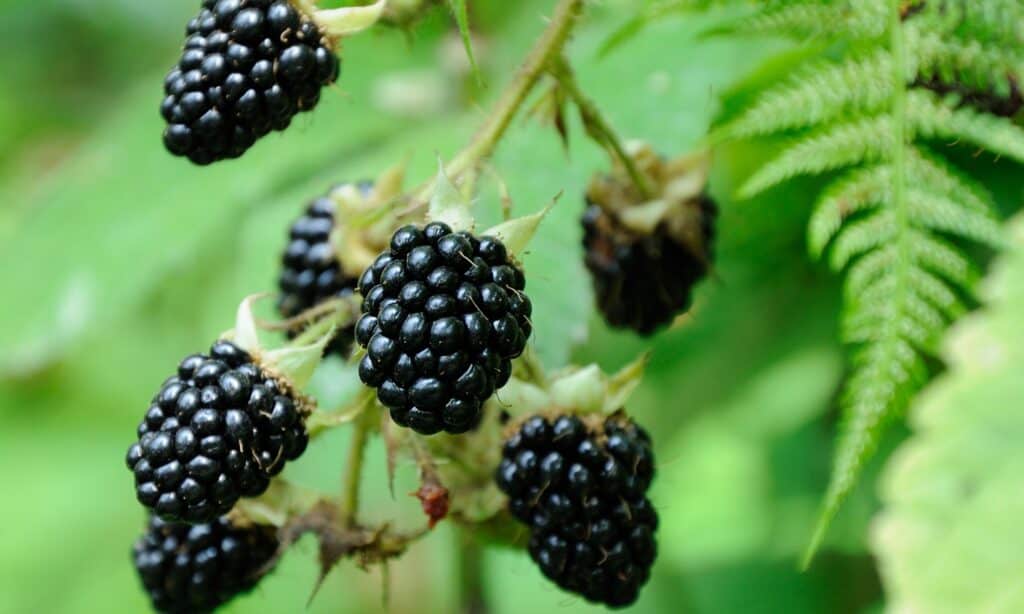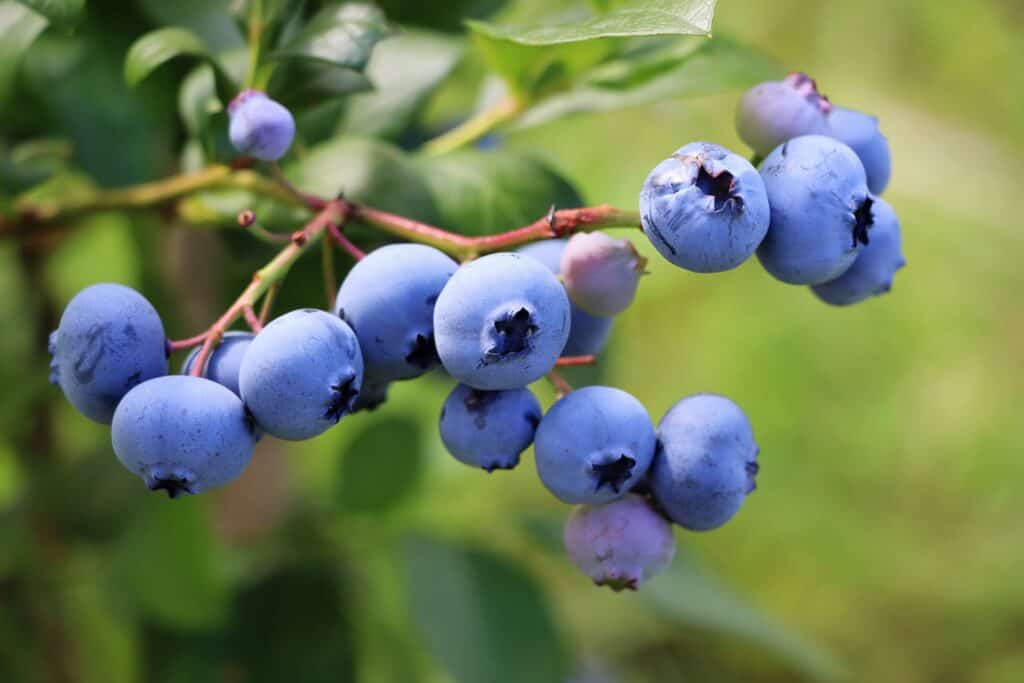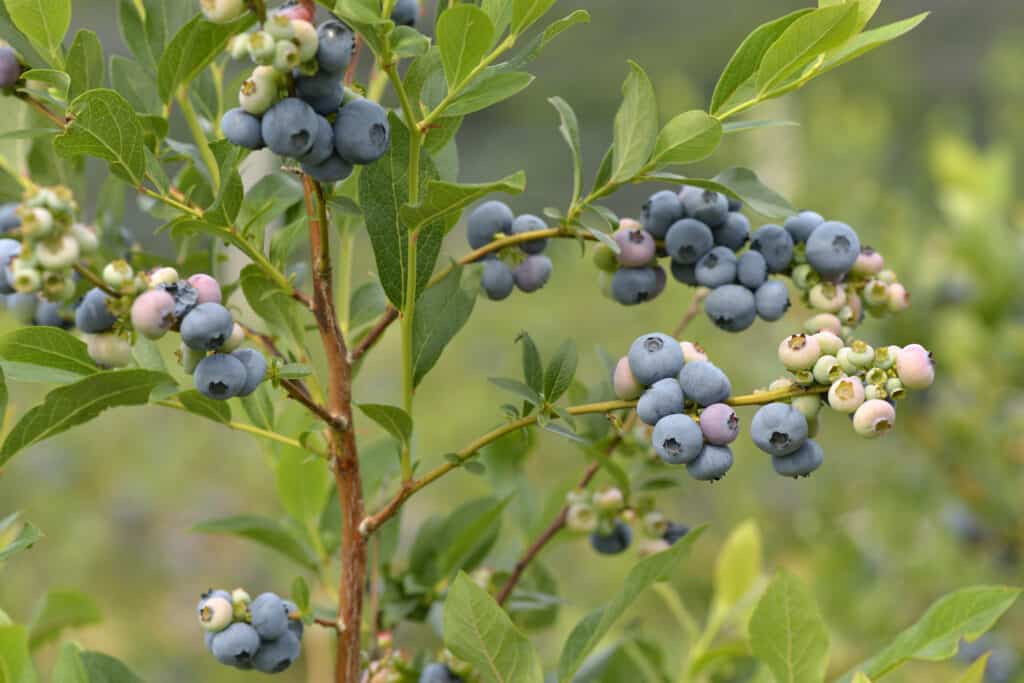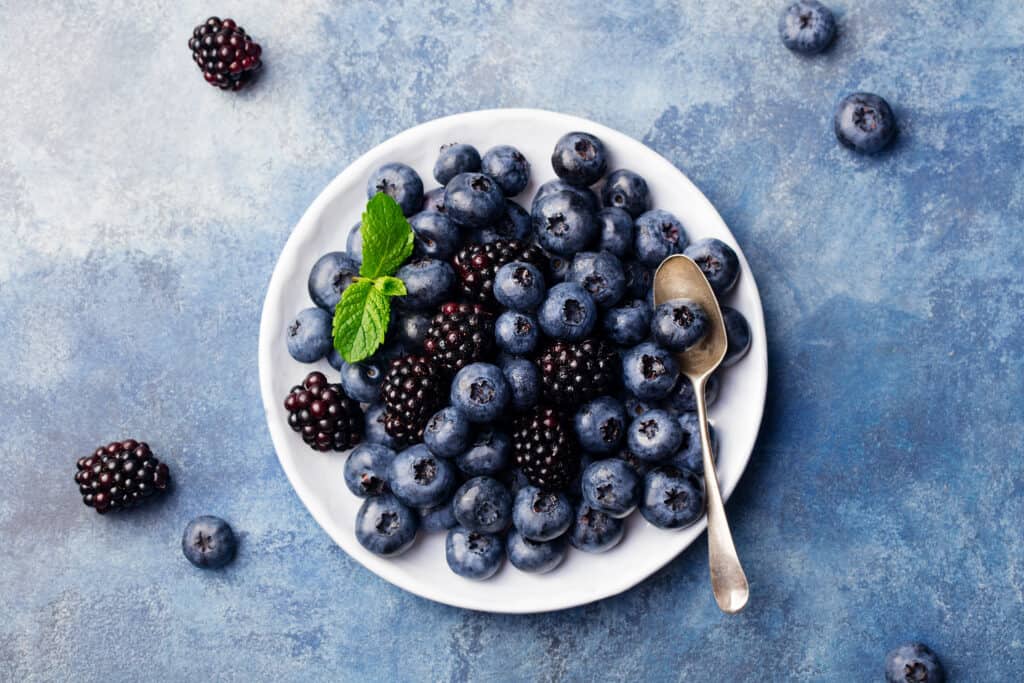Blackberries and blueberries are both tasty, healthy fruits, and they have very similar names that point out one obvious difference — their color! However, these two fruits are very different plants. Let’s take a closer look at blackberry vs blueberry and find out how these two fruits differ.
Main Differences Between Blackberry and Blueberry
These are two very different plants! The main differences between blackberry vs. blueberry are their native ranges, foliage, berries, and soil needs.
| Name | Blackberry (rubrus) | Blueberry (vaccinium) |
| Foliage | Palmate, green and prickly, evergreen | Pointed green ovals, deciduous, red in fall |
| Fruits | Black aggregate drupelets form fruit | Round blue or purple individual berries |
| Flowers | White or pink star shapes with five petals | White or pink bells |
| Native to | North and South America, Europe, North Africa, and Asia | North America |
| Growing conditions | Well drained soil; will cope with wasteland | Acidic, consistently damp soil |
| Toxicity | Not toxic | Not toxic |
Origins of Blackberry vs. Blueberry
All About Blackberries

There are 375 blackberry species!
©iStock.com/syaber
Blackberry plants are in the Rosaceae family and the rubrus genus. They are an aggregate fruit named because each blackberry fruit is made up of many small druplets that make a blackberry.
There are 375 blackberry species, and they are sometimes called cane fruits, Blackberries have a huge native range including Europe, North and South America, West and Central Asia, and Northwestern Africa.
Our ancestors ate blackberries and we know this because the 2,500 year old Haraldskaer woman (a Danish bog body) had undigested blackberries in her stomach. The ancient Greeks, Romans and native Americans ate blackberries, made drinks including teas and wine, dyed material, and created medicine from their fruits, stems, and bark. Wild blackberry picking is popular in Britain, but there’s a tradition that after Michaelmas Day the devil steps on blackberries so they turn sour.
All About Blueberries

Blueberries often come in lowbush or highbush varieties.
©vaivirga/Shutterstock.com
Blueberries are in the Cyanococcus family and the genus Vaccinium along with cranberries and huckleberries. The blueberry shrub produces numerous blue, round berries with a small, flared end. Blueberries are native to North America and were introduced to Europe in the 1930s.
There are several types of blueberry bushes. The wild type is prostrate (low growing) and called the lowbush blueberry. This one ranges from four inches to 13 feet tall and grows on forest floors or near swamps.
Cultivated highbush blueberries were introduced in the 1900s in New Jersey. The most frequently grown is the northern highbush blueberry because it most suits the climates and it’s easier to pick.
Blackberry vs. Blueberry Growing Zones
Wild blackberries can cope with zone 3, but those in cultivation generally grow best in zones four to eight. Blueberries have a similar range and will fruit readily in zones four to eight.
Are They Perennial?
Blackberry bushes are perennials with biennial stems, which means the whole plant lives for years, but the fruiting stem takes two years to bear fruit. In year one the “primocane” stem grows, then in year two the “floricane” flowers and fruits.
Blueberries are also perennials, and the best fruits grow on newer stems from the previous few years.
Blackberry vs. Blueberry: Foliage and stems

Blackberry plants are best planted in September.
©Miriam Doerr Martin Frommherz/Shutterstock.com
The plants of blueberries and blackberries are quite different. Blackberry plants have very sharp prickles and canes that can reach 30 feet in length, so they’re sometimes called brambles. If they’re not managed, blackberries form a dense tangle of stems, and their tips can root straight into the soil. They colonize woodlands and hedgerows quickly and are quite happy in poor wasteland soil.
Blackberry foliage starts life on the primocane as a green palmate leaf with up to seven leaflets. In the second year, side shoots emerge with smaller leaves that have three to five leaflets. The backs of the leaflets have prickles and they are rough to touch.
In contrast, new blueberry foliage emerges green each year with a reddish tinge and grows to about one to two inches long. The leaves have a pointed tip and paler coloring beneath. In fall, blueberry foliage turns rich red.
Are Blueberries Deciduous?
Deciduous means the plant loses its foliage in fall and replaces it in spring.
Blueberries are usually deciduous because most cultivars are bred from the deciduous northern high bush blueberry, Vaccinium corymbosum.
In contrast, blackberries are evergreen. They only lose their foliage in very cold freezing temperatures, and even then, they remain semi-evergreen.
Blackberry vs. Blueberry: Flowers
Blackberry flowers emerge in late spring. They are white to pink and measure around one inch across. Pollinators love blackberry flowers and thickets are always abuzz with bees in late spring to early summer.
Blueberry flowers are very different from blackberry flowers. They are still small and pink or white, but instead of open star shapes they’re produced in sprays that hang down like bells. Some gardeners like to grow blueberry bushes just for the pretty blooms and they leave the berries for birds or mammals.
Blackberry vs. Blueberry: Fruit
Blackberry fruits are aggregate drupelets. If you look closely, you can see each fruit is made up of many small and round black drupelets. Only the parts that were fertilized turn black, which is why sometimes you can see small hard green sections in your blackberry. Blackberries are tasty fruits that turn sweeter in the sunshine, so birds and small mammals such as mice and voles eat them as part of their natural diet.
Blueberries are smaller, only measuring up to 5/8 of an inch. They have a flared end where the flower was set and range from deep blue to almost purple. Each blueberry is covered with protective wax called the bloom. Birds and mammals also enjoy blueberries!
Both blackberries and blueberries are very tasty and good for human health too.
How To Grow Blackberry and Blueberry

Beautiful blueberries of summer ready for picking. Blueberries grow best in neutral to acidic soil.
©iStock.com/hbak
Wild blackberries are hard work and difficult to cut back because their prickles can tear through clothes, but there are domesticated cultivars that are much less dangerous. Some are thornless and they don’t grow 30 feet long canes, but stop at four to five feet tall. Most hybridization occurred in the States and the cultivars Black Pearl or Nightfall are popular.
Blackberries will grow in most well-drained soils. They require support to scramble up, so wire canes or trellis are needed. Water them when the flowers appear and when their fruit has passed, cut away the fruited stems. Be sure to leave the new primocanes in place because those will bear the following year’s fruit.
Both low-bush and high-bush blueberries grow best in neutral to acidic soil with a pH of 4.2 to 5.5, so in chalky gardens it’s best to use a container. If the soil is too alkaline your blueberries will have spindly stems and pale yellow foliage. This is an iron or magnesium deficiency called chlorosis.
Blueberries will grow without fuss for three years and then one out of every three canes should be cut to the ground because blueberries fruit best on newer canes. There are many easy-to-grow blueberry cultivars including Biloxi, Bluecrop, and Blueray that reach around four to five feet tall.
Cultivated blackberries and blueberries produce the most fruits in pollinator-friendly gardens and they need plenty of water as the fruit begins to develop. However, because they prefer acidic conditions blueberries are best drenched with rainwater rather than tap water.
Are Blackberries or Blueberries Toxic to Dogs?
Blackberries are not toxic to dogs, but too many will cause stomach upsets, and it’s the same for blueberries! Blueberries are good for dogs, but beware of giving too many in one go.

Both blueberries and blackberries are tasty and delicious!
©iStock.com/AnnaPustynnikova
Which Is Best: Blackberry vs. Blueberry?
Both plants produce small edible fruits that are sweet and healthy. They also attract pollinators, birds, and mammals to the garden. The biggest difference is your preference and the soil you have available. Blueberries need acidic soil, so unless you’re willing to grow your berries in a pot, black berries might be a better choice.
Either way, you’ll have plenty of healthy berries for your cereal and snacks during the summer months!
Up Next:
- Raspberries vs. Blueberries: What Are the Differences?
- Huckleberries vs. Blueberries: Is There a Difference?
- Bilberries vs. Blueberries: What’s the Difference?
The photo featured at the top of this post is ©
Sources
- Royal Horticultural Society, Available here: https://www.rhs.org.uk/fruit/blackberries-and-hybrid-berries/grow-your-own
- Royal Horticultural Society, Available here: https://www.rhs.org.uk/fruit/blueberries/grow-your-own
Thank you for reading! Have some feedback for us? Contact the AZ Animals editorial team.






